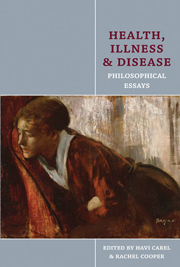Book contents
- Frontmatter
- Contents
- Acknowledgements
- Contributors
- Introduction
- Part I Concepts of health and disease
- Part II The experience of illness
- 5 What is phenomenology of medicine? Embodiment, illness and being-in-the-world
- 6 Beyond the wounded storyteller: rethinking narrativity, illness and embodied self-experience
- 7 Transitions in health and illness: realist and phenomenological accounts of adjustment to cancer
- 8 Pain as illness
- Part III Illness and society
- Bibliography
- Index
8 - Pain as illness
from Part II - The experience of illness
- Frontmatter
- Contents
- Acknowledgements
- Contributors
- Introduction
- Part I Concepts of health and disease
- Part II The experience of illness
- 5 What is phenomenology of medicine? Embodiment, illness and being-in-the-world
- 6 Beyond the wounded storyteller: rethinking narrativity, illness and embodied self-experience
- 7 Transitions in health and illness: realist and phenomenological accounts of adjustment to cancer
- 8 Pain as illness
- Part III Illness and society
- Bibliography
- Index
Summary
INTRODUCTION
In 1976, Ivan Illich argued that one of the problems historians of pain have to face is the “profound transformation undergone by the relationship of pain to the other ills man can suffer” (Illich 1975: 97). Illich argues that “pain has changed its position in relation to grief, guilt, sin, anguish, fear, hunger, impairment and discomfort … it seems as if pain were now only that part of human suffering over which the medical profession can claim competence or control” (Illich 1975: 97).
In Western culture, pain is a medical problem: this means that pain experience cannot be correctly understood without addressing the medical framework in which pain is lived today. My primary aim in this chapter is to analyse the ways in which contemporary biomedicine has tried to handle the complexity of pain, particularly when it becomes a disease.
I will start by introducing the gate control theory of pain – a theory formulated in 1956 that has profoundly changed current neurophysiological conception of pain mechanisms. Gate control theory has superseded the previous specificity theory, allowing a better understanding of pain, elucidating some problematic painful conditions in which the link between injury and pain was not so clear as specificity theory postulated. Gate control indicates instead that there is always a variable relationship between stimulus and pain perception, and highlights the contribution of psychological factors to pain perception.
I then discuss the definition of pain formulated by the International Association for the Study of Pain (IASP), drawing attention to how some controversial issues stemming from the medical conception of chronic pain may derive from an organic/psychological distinction between different kinds of pain already present in the definition.
- Type
- Chapter
- Information
- Health, Illness and DiseasePhilosophical Essays, pp. 143 - 158Publisher: Acumen PublishingPrint publication year: 2012

